|
|
|
|
|
Intel "Pentium D" and "840 Extreme Edition" Dual-Core CPUs |
|
Join the community - in the OCAU Forums!
|
Chipsets, Testing Methodology
NEW INTEL CHIPSET PLATFORMS FOR PENTIUM D:
The Pentium D launch triggered a flurry of related Intel product releases. Because the new dual cores processors do not run with the existing 865/875 or 915/925 chipsets, Intel released 3 new chipsets: 955X, 945P and 955G. And, because Intel is not only producing processors and chipsets but also motherboards, several new boards based on these chipsets were released as well. In addition to Intel’s 945/955 chipset family, nVidia’s “nForce 4 Intel Edition” is supporting Pentium D 840 and 830, however it seems that the 820 runs due to still unknown reasons only in single core mode with this chipset.
The difference between the 915/925 and 945/955 chipset families is first of all support for dual core CPUs. Furthermore the user gets native support for DDR2 667 and SATA II. This second generation SATA standard comes with “native command queuing” and a theoretical interface transfer speed of up to 3 GB/sec. These features are implemented by virtue of the new ICH7 that accompanies all 945/955 chipsets. Other ICH features like Intel’s Matrix Raid and 8-channel high-definition sound remain unchanged from the ICH6 implemented with 915/925 chipsets. Intel is recommending the 955X chipset specifically for usage with the dual core 840XE, but of course all other LGA775 P4 CPUs run with it as well. The 955X comes, unlike its 945 sibling, with “Memory Pipeline Technology” which is according to Intel “enabling a higher utilization of each memory channel, accelerating data transfers between the processor and system memory and resulting in higher system performance.” In our test Intel‘s 955X reference board indeed delivered around 5% better bandwidth than the 945G reference board, but system performance when application and games were running was identical. It goes without saying that 955X boards will be priced higher than 945 boards, not so much because Intel is charging more for the chipset, but because motherboard manufacturers will position 955X boards as flagship products and load them with everything that money can buy.
The 945 variants are recommended for usage with Pentium D 820, 830 and 840. The 945 chipset supports entry level 500 processors with a system bus speed of 533 MHz. As with previous chipset families Intel is offering a version with an integrated graphics core. The 945G chipset comes with the new 256-bit GMA 950 graphics core running at 400 MHz, up to 10.6 GB/sec memory bandwidth and up to 224 MB maximum video memory. Otherwise there isn’t much difference between the 945G and 945P chipset. The GMA 950 core allows playing newer 3D games only in low resolutions. This integrated graphic core is a good solution for business purposes and users who don’t require 3D performance, but gamers will look for an add-in graphic card. We believe that 945P based motherboards will be quite popular, because they perform at the level of 955X boards but will be a good deal cheaper.
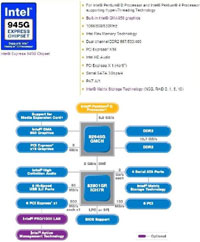 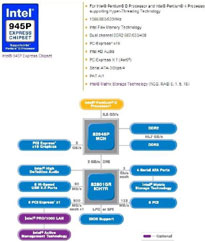 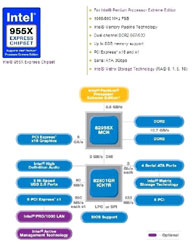
TESTING METHODOLOGY AND SET-UP:
In this article we are reviewing the Pentium D 820 and 840 as well as the “840 Extreme Edition”. At 2.8 GHz the 820 is the lowest clocked and cheapest dual core product Intel is offering and so to speak the "entrance" into dual core computing. The 840 and the 840XE are both clocked at 3.2 GHz. As already mentioned the difference between them is HT. Additionally the 840XE comes with an unlocked multiplier. The 840XE has HT enabled and can run with 4 “virtual” cores. The 840 has HT disabled and runs with only 2 cores. That means that by disabling HT via the motherboard’s BIOS, the 840XE essentially becomes an 840. Unfortunately it does not work the other way around. So far nobody has found a way to enable HT on CPUs that are sold by Intel with HT disabled. For comparison purposes we included the offerings from Intel and AMD that are sold at roughly the same price point as a Pentium 820 D. That is a P4 630 (3.0 GHz) and an A64 3500+ (2.2 GHz). The 840XE will be compared with Intel’s highest clocked single core Extreme Edition, the 3.73 XE, and with AMD’s fastest dual core offering for desktops, the A64 X2 4800+.
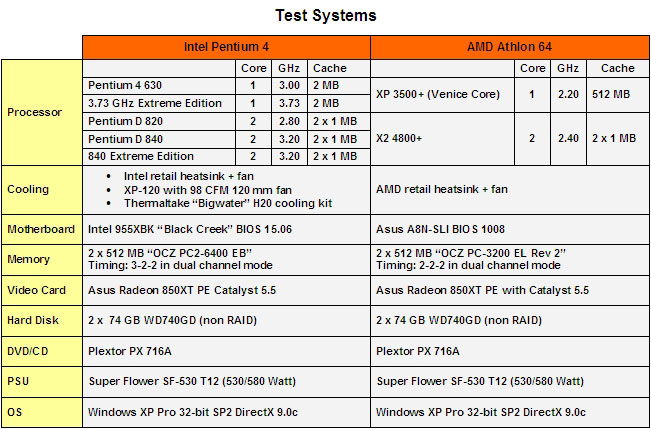
Unfortunately we could not source the pricewise equivalent AMD dual core offering to the Pentium D 840. As the cheapest X2 product, the X2 4200+ will for sure be the most popular choice. We want to point out that the purpose of this article is reviewing Intel’s dual core offering; its intention is not a comprehensive comparison of Intel’s and AMD’s dual core products and technology.
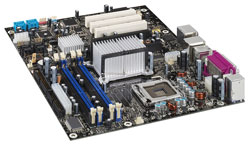
Our test platform is the 955X reference motherboard, the 955XBK “Black Creek”. This board also comes with the 4-channel SI 3114 SATA RAID controller from Silicon Images that uses the high speed PCI-E bus. In total the user has 8 SATA channels available. In addition to IEEE1398a the 955XBK supports also the “b” standard with a doubled bandwidth of up to 800 MB/sec. The board comes with an 8-pin EPS plug for the processor power supply. Such a more powerful power supply is normally used for multiprocessor server boards.
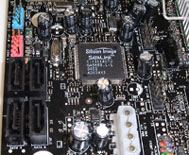 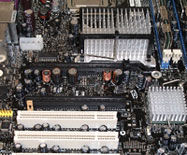 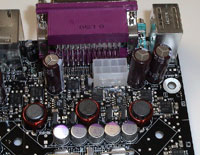
The D955XBK BIOS allows the user to run a dual core CPU in single core mode as well. It gives access to memory timings, memory voltage, and allows running the memory at 533, 667, and 800 MHz. The memory voltage can be set between 1.7 and 2.08 volt. Processor overclocking is limited to 10% on top of default FSB frequency but without the possibility to change the CPU voltage. However, if the D955XBK is used with an 840XE it becomes possible to increase the FSB frequency up to 30%, and miraculously settings for CPU voltage and CPU multiplier appear. This makes sense, because the 840XE comes with an unlocked multiplier. These features however are only available when an 840XE is running with the D955XBK. If another processor is used, even the 3.743 GHz Extreme Edition, these advanced overclocking features are not available and the D955XBK allows overclocking FSB frequency only by 10%. Intel’s intention is obviously to make the 840XE and the D955XBK as attractive as possible for “enthusiast” DIY users and to justify the hefty surcharge for the 840XE. The 955XBK, as do a few other 955 boards, comes with 2 PCI-E x16 connectors. This initially invited speculation that later with appropriate driver support a SLI-like dual graphics feature would be possible with 955 boards. However, the technical documentation makes it clear that the secondary x16 card connector is an electrical equivalent of a PCI Express x4 bus add-in card connector. It supports therefore only x4 and x1 PCI Express add-in cards. Only the primary x16 connector allows running a PCI-E graphics at x16 with up to 8 GB/sec bandwidth.
|
|
Advertisement:
All original content copyright James Rolfe.
All rights reserved. No reproduction allowed without written permission.
Interested in advertising on OCAU? Contact us for info.
|

|


